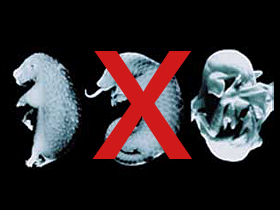Any mammal undergoes a developmental process in its mother’s womb. The claim that embryological development in living things is evidence for evolution, however, is known as the Recapitulation theory in evolutionist literature. (See Recapitulation theory.) A number of evolutionist publications and textbooks today seek to portray this theory of recapitulation which had previously been removed from the scientific literature, as a scientific fact.
|
|
The term “recapitulation” is an abbreviated version of the “Ontogeny recapitulates phylogeny” axiom proposed by the evolutionist biologist Ernst Haeckel in the 19th century. Haeckel, the father of the recapitulation theory, resorted to fabricated drawings to back up his fictitious thesis. (See Haeckel, Ernst.) Certain circles who have conditioned themselves to support the theory of evolution still seek to portray his falsified drawings as evidence of embryological evolution.
According to Haeckel’s theory embryos repeat the evolutionary process during their developmental stages. The human embryo, for instance, first exhibits fish-like features and then reptilian ones during its development in the womb before finally resembling a human being.
In later years, however, it emerged that this scenario was wholly imaginary. The supposed gills that appeared during an embryo’s earliest stages were determined in fact to be the middle ear canal and the beginning of the parathyroid and thymus glands. That part of the embryo formerly compared to the yolk sac was revealed to be a sac producing blood for the baby. That part that Haeckel and his followers described as the tail is actually the backbone, which resembles a tail only because it develops before the legs.
These facts are known to everyone in the world of science. Evolutionists also accept them. As George Gaylord Simpson, one of the founders of neo-Darwinism, writes, “Haeckel misstated the evolutionary principle involved. It is now firmly established that ontogeny does not repeat phylogeny.” 138
138 G.G. Simpson, W. Beck, An Introduction to Biology, New York: Harcourt Brace and World, 1965, p. 241.
139 Elizabeth Pennisi, “Haeckel’s Embryos: Fraud Rediscovered”, Science, 5 September 1997: Vol. 277. no. 5331, p. 1435.



